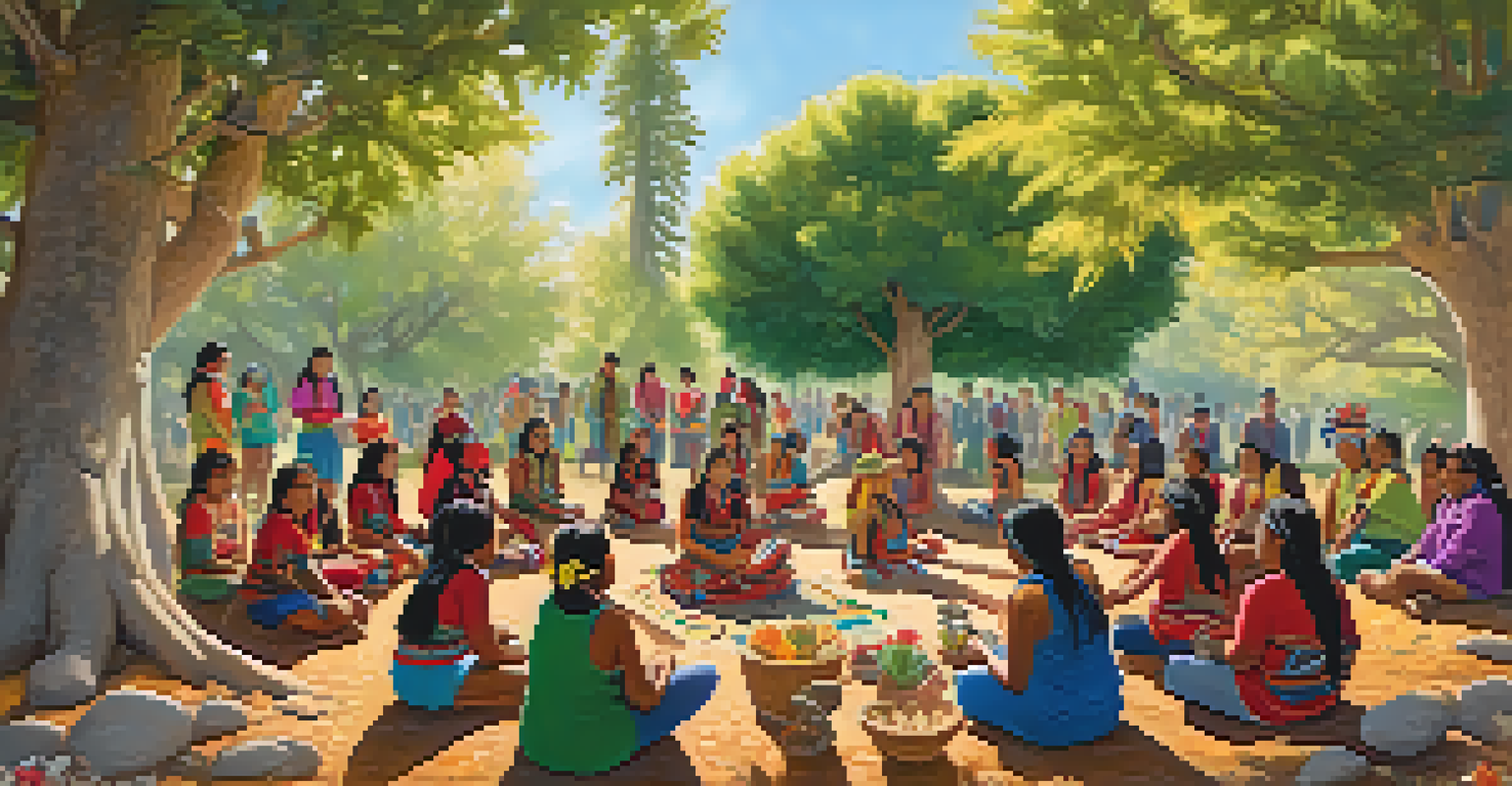The Legacy of Peyote Use in Indigenous Cultural Practices

Understanding Peyote: A Sacred Plant in Indigenous Traditions
Peyote, a small cactus native to Mexico and the southwestern United States, has been used for centuries in Indigenous cultural practices. This plant holds significant spiritual value, often seen as a gift from the Creator that fosters deep connections to the spiritual world. Many Indigenous tribes consider peyote a teacher, guiding them through profound experiences that promote healing and insight.
Peyote is a teacher, a guide that helps individuals connect with the spiritual realm and discover their true selves.
The traditional use of peyote is often intertwined with ceremonial practices, where it is consumed during rituals to enhance spiritual awareness. These ceremonies serve not only as a means of connecting with the divine but also as a way to strengthen community bonds among participants. Through the shared experience of peyote, individuals find a sense of unity and collective healing.
Peyote use is not merely recreational; it is a deeply respected practice that requires preparation and intention. Elders and spiritual leaders often facilitate these ceremonies, ensuring that participants understand the cultural significance and proper usage of the plant. This careful approach highlights the reverence Indigenous cultures hold for peyote and its role in their spiritual journeys.
Historical Context: Peyote Use Across Indigenous Communities
The history of peyote use spans thousands of years, with archaeological evidence suggesting its consumption since prehistoric times. Various Indigenous tribes, including the Huichol, Navajo, and Lakota, have incorporated peyote into their spiritual traditions, each adapting its use to fit their unique cultural contexts. This rich history illustrates the plant's enduring significance in Indigenous societies.

During the 19th century, peyote gained attention from non-Indigenous people, which led to both fascination and misunderstanding. While some viewed it as a curious substance, many Indigenous peoples defended their right to practice their traditional ceremonies without interference. This resistance was crucial in preserving the cultural integrity of peyote use amid external pressures.
Peyote's Spiritual Significance
Peyote is revered in Indigenous cultures as a sacred plant that fosters deep spiritual connections and communal healing during ceremonies.
The establishment of the Native American Church in the early 20th century marked a pivotal moment in the modern practice of peyote use. This organization sought to protect the religious rights of Indigenous peoples, advocating for the legal use of peyote in spiritual ceremonies. This movement not only legitimized the practice but also fostered a sense of pride in Indigenous identity.
Peyote Ceremonies: Structure and Significance
Peyote ceremonies are rich in symbolism and structure, often lasting several hours or even days. These gatherings typically begin with a prayer, invoking the spirit of the plant and asking for guidance and protection. Participants sit together in a circle, creating a safe space for sharing experiences and support throughout the journey.
The strength of Indigenous cultures lies in their ability to adapt and remain resilient while honoring their traditions.
During the ceremony, peyote is consumed in various forms, such as fresh, dried, or brewed into tea. The effects of peyote can lead to altered states of consciousness, allowing participants to engage in deep introspection and connection with the spiritual realm. This transformative experience is often accompanied by singing, drumming, and storytelling, which enhance the communal aspect of the ritual.
The significance of these ceremonies extends beyond individual experiences; they serve as vital cultural touchstones that reinforce community identity. By participating in peyote ceremonies, individuals honor their ancestors and affirm their connection to their cultural heritage. This continuity of practice plays a crucial role in keeping Indigenous traditions alive.
The Role of Elders in Peyote Traditions
In Indigenous cultures, elders hold a revered position, particularly in the context of peyote ceremonies. They are seen as the custodians of knowledge and tradition, guiding younger generations in the respectful use of peyote. Elders often share stories and teachings that enrich the spiritual experience, emphasizing the importance of reverence and responsibility.
Elders also play a critical role in preparing for ceremonies, ensuring that the environment is conducive for spiritual work. Their presence provides wisdom and stability, helping participants navigate the sometimes daunting effects of peyote. This mentorship fosters a sense of safety and encourages open communication about the experiences that arise during the ceremonies.
Cultural Preservation Efforts
Indigenous communities are actively working to revitalize peyote practices among younger generations to maintain their cultural identity and heritage.
By passing down their knowledge, elders ensure that the traditions surrounding peyote use are preserved and respected. This generational connection strengthens community ties and reinforces the cultural significance of peyote within Indigenous practices. It highlights the value of intergenerational learning in maintaining the integrity of cultural heritage.
Modern Challenges: Legal and Social Issues Surrounding Peyote
Despite its deep-rooted cultural significance, the use of peyote faces numerous challenges in modern society. Legal restrictions and misunderstandings often hinder Indigenous peoples' rights to practice their traditions freely. Many tribes continue to advocate for the protection of their sacred practices, emphasizing the need for cultural sensitivity and respect from wider society.
The increased interest in psychedelics for therapeutic purposes has led to both opportunities and concerns for Indigenous communities. While some see this as a chance to educate others about the spiritual significance of peyote, there is also apprehension about cultural appropriation and commercialization. It’s essential to approach these discussions with respect for Indigenous sovereignty and cultural heritage.
Efforts to address these challenges are ongoing, with many Indigenous leaders pushing for legal recognition and protection of peyote use in spiritual practices. By advocating for their rights, they aim to preserve the integrity of their traditions and ensure that future generations can continue to experience the profound benefits of peyote. This struggle reflects a broader movement for Indigenous rights and cultural preservation.
The Ecological Impact of Peyote Harvesting
Harvesting peyote is not without its ecological challenges, as overharvesting can threaten this sacred plant's sustainability. The increasing demand for peyote due to both cultural and recreational interest has raised concerns among Indigenous tribes. Many are advocating for sustainable harvesting practices to ensure that peyote can continue to thrive in its natural habitat.
Indigenous peoples have long practiced sustainable harvesting techniques, respecting the land and the plant's life cycle. These practices often involve taking only what is needed for ceremonial purposes and allowing the remaining plants to regenerate. This approach not only preserves the ecosystem but also reflects the deep respect Indigenous cultures have for nature.
Challenges Facing Peyote Use
Modern legal restrictions and concerns about cultural appropriation pose significant challenges for Indigenous peoples in practicing their traditional peyote ceremonies.
Efforts are underway to educate both Indigenous and non-Indigenous communities about the importance of sustainable practices. By fostering a greater understanding of the ecological issues surrounding peyote, advocates hope to protect this vital resource for future generations. This initiative underscores the interconnectedness of cultural practices and ecological stewardship.
Celebrating the Future: Revitalization of Peyote Practices
As Indigenous communities continue to face modern challenges, there is a growing movement to revitalize peyote practices among younger generations. Many tribal leaders are working to engage youth in traditional ceremonies, ensuring that the knowledge and significance of peyote are passed down. This revitalization is crucial for maintaining cultural identity and heritage.
Workshops, gatherings, and educational programs are being organized to teach younger members about the spiritual, cultural, and ecological aspects of peyote. By fostering a sense of pride and connection, these efforts encourage youth to embrace their cultural heritage. This renewed interest not only strengthens community ties but also empowers individuals to be stewards of their traditions.

The future of peyote practices looks promising as more Indigenous peoples advocate for the recognition and respect of their traditions. By celebrating their heritage and sharing their knowledge, Indigenous communities are paving the way for a deeper understanding of the importance of peyote. This journey toward cultural revitalization embodies resilience and the enduring spirit of Indigenous peoples.